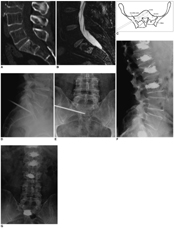Korean J Radiol.
2008 Dec;9(6):572-576. 10.3348/kjr.2008.9.6.572.
Percutaneous Sacroplasty for Sacral Metastatic Tumors Under Fluoroscopic Guidance Only
- Affiliations
-
- 1Department of Radiology, Sixth Affiliated People's Hospital, Shanghai Jiao Tong University, Yi Shan Road Shanghai, China. zh_ji@hotmail.com
- KMID: 1118882
- DOI: http://doi.org/10.3348/kjr.2008.9.6.572
Abstract
- Percutaneous sacroplasty is a safe and effective procedure for sacral insufficient fractures under CT or fluoroscopic guidance; although, few reports exist about sacral metastatic tumors. We designed a pilot study to treat intractable pain caused by a sacral metastatic tumor with sacroplasty. A 62-year-old man and a 38-year-old woman with medically intractable pain due to metastatic tumors of S1 from lymphoma and lung cancer, respectively, underwent percutaneous sacroplasty. Over the course of the follow-up period, the two patients experienced substantial and immediate pain relief that persisted over a 3-month and beyond. The woman had deposition of PMMA (polymethyl methacrylate) in the needle track, but did not experience significant symptoms. No other peri-procedural complications were observed for either patient.
MeSH Terms
Figure
Cited by 1 articles
-
Percutaneous Sacroplasty for Painful Sacral Metastases Involving Multiple Sacral Vertebral Bodies: Initial Experience with an Interpedicular Approach
Qing-Hua Tian, He-Fei Liu, Tao Wang, Ying-Sheng Cheng, Chun-Gen Wu
Korean J Radiol. 2019;20(6):939-946. doi: 10.3348/kjr.2018.0803.
Reference
-
1. Strub WM, Hoffmann M, Ernst RJ, Bulas RV. Sacroplasty by CT and fluoroscopic guidance: is the procedure right for your patient? AJNR Am J Neuroradiol. 2007. 28:38–41.2. Pommersheim W, Huang-Hellinger F, Baker M, Morris P. Sacroplasty: a treatment for sacral insufficient fractures. AJNR Am J Neuroradiol. 2003. 24:1003–1007.3. Dehdashti AR, Martin JB, Jean B, Rufenacht DA. PMMA cementoplasty in symptomatic metastatic lesions of the S1 vertebral body. Cardiovasc Intervent Radiol. 2000. 23:235–237.4. Uemura A, Fujimoto H, Yasuda S, Osaka I, Goto N, Shinozaki M, et al. Transcatheter arterial embolization for bone metastases from hepatocelluar carcinoma. Eur Radiol. 2001. 11:1457–1462.5. Pascal-Moussellard H, Broc G, Pointillart V, Simeon F, Vital JM, Senegas J. Complications of vertebral metastasis surgery. Eur Spine J. 1998. 7:438–444.6. Sundaresan N, Sachdev VP, Holland JF, Moore F, Sung M, Paciucci PA, et al. Surgical treatment of spinal cord compression from epidural metastasis. J Clin Oncol. 1995. 13:2330–2335.7. Kelekis A, Lovblad KO, Mehdizade A, Somon T, Yilmaz H, Wetzel SG, et al. Pelvic osteoplasty in osteolytic metastases: technical approach under fluoroscopic guidance and early clinical results. J Vasc Interv Radiol. 2005. 16:81–88.8. Li AF, Li KC, Chang FY, Hsieh CH. Preliminary report of transpedicle body augmenter vertebroplasty in painful vertebral tumors. Spine. 2006. 31:E805–E812.9. Baroud G, Samara M, Steffen T. Influence of mixing method on the cement temperature-mixing time history and doughing time of three acrylic cements for vertebroplasty. J Biomed Mater Res B Appl Biomater. 2004. 68:112–116.10. Belkoff SM, Molloy S. Temperature measurement during polymerization of polymethylmethacrylate cement used for vertebroplasty. Spine. 2003. 28:1555–1559.
- Full Text Links
- Actions
-
Cited
- CITED
-
- Close
- Share
- Similar articles
-
- Percutaneous Sacroplasty for the Sacral Insufficiency Fracture Caused by Metastasis
- Transiliac sacroplasty for Denis 3 fracture: Two cases report
- Therapeutic Considerations of Percutaneous Sacroplasty for the Sacral Insufficiency Fracture
- Percutaneous Iliosacral Screw Fixation with Cement Augmentation in Sacral Insufficient Fracture: A Case Report
- Percutaneous Sacroplasty for Painful Sacral Metastases Involving Multiple Sacral Vertebral Bodies: Initial Experience with an Interpedicular Approach



